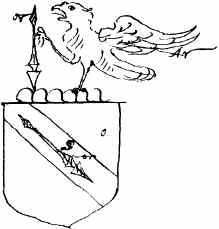A gentleman born
In October 1596, the College of Heralds granted a coat of arms to the family patriarch, John Shakespeare.
The grant was approved on the basis of the "faithefull & approved service to H7 [Henry VII]" performed by John's great-grandfather, and because John himself had "maryed the daughter & one of the heyrs of Robert Arden of Wellingcote."
The description of the coat of arms:
Gould, on a Bend, Sables*, a Speare of the first steeled argent*. And for his creast or cognizaunce a falcon, his winges dispplayed Argent standing on a wreath of his coullers*.
Shakespeare's works show that he was familiar with the technical terminology of heraldry.*
Gentleman born?
In The Winter's Tale, the old Shepherd and his son decide that they are "gentlemen born" when they are knighted in Act 5 because of their loving treatment of Perdita, found abandoned on the shore (5.2.135).
Footnotes
-
Technical terms
- bend
- A diagonal band across a shield from the upper left corner to the bottom right.
- sables
- Black.
- steeled
- Of a spear, when referring to the point.
- argent
- Silver.
- coullers
- The colours of the Shakespeare family.
-
Shakespeare's knowledge of heraldry
The Player in Hamlet speaks a passage in heightened rhetoric:
The rugged Pyrrhus, he whose sable arms,
Black as his purpose, did the night resemble
When he lay couched in th' ominous horse,
Hath now this dread and black complexion smear'd
With heraldy more dismal: head to foot
Now is he total gules, horridly trick'd
With blood of fathers, mothers, daughters, sons,
Bak'd and impasted with the parching streets,
That lend a tyrannous and a damned light
To their lord's murther. Roasted in wrath and fire,
And thus o'er-sized with coagulate gore,
With eyes like carbuncles, the hellish Pyrrhus
Old grandsire Priam seeks.
(Hamlet, 2.2.452-64)- sable
- Black.
- gules
- Blood-red.
